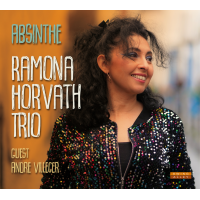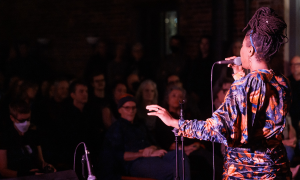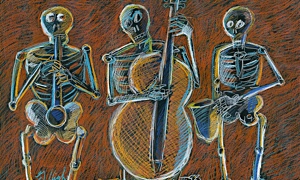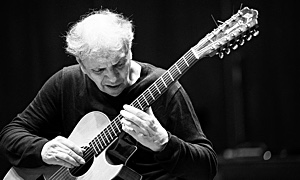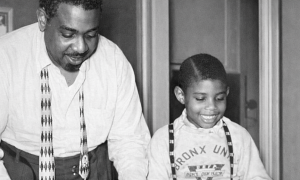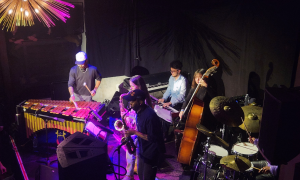Home » Jazz Articles » What is Jazz? » Tuesday Night Jams at the Owl: A 25 Year Legacy in Seattle
Tuesday Night Jams at the Owl: A 25 Year Legacy in Seattle

Courtesy Lisa Hagen Glynn
It started out as a weed and turned into a beautiful tree that continues to grow.
—Jose Dionisio Martinez
On Tuesday nights, the back bar transforms into a jazz nightspot, hosting a vibrant jam session that dates back to 1995. On April 28, 2021, the session took on more than the traditional role on the jazz scene in Seattle—it served as a place of transformation, of healing, of reacquaintance, after a year enduring the darkness brought on by the Covid-19 pandemic.
The session begins with an hour set by the host musicians, followed by a jam session that traditionally does not include a sign up sheet. On this evening, the tables were spread out for social distancing, musicians and patrons alike were masked. Session host Eric Verlinde was at the piano, joined by drummer D'Vonne Lewis, bassist Stanley Ruvinov and trumpeter Thomas Marriott. As Marriott led the band into Tadd Dameron's "Hot House," an overwhelming feeling of joy and community seemed to magically arise in the room. For the audience, whether lifelong jazzers, or casual passerbys, it was the first live music they had witnessed in over a year. Dormant emotions awakened, this most social music was nourishing that which had remained distant for so long— normal socialization, community and the artistry of jazz that had united us in the first place.
There is a casual timelessness to the evening, a grounding dose of fellowship where a community can return to its collective roots on a weekly basis for some 26 years. The hang is the thing to locals and to out of towners who drop in and feel the welcoming vibe that flies in the face of the "Seattle freeze" that is frequently and falsely alleged. Before the Covid-19 pandemic, the session started at 10 pm and ran to 1 or 2 am. Musicians and patrons alike would drop in after gigs at Tula's, Jazz Alley, Egan's or the Triple Door. Touring musicians would often drop by after their respective gigs. Seattleites learned to expect the unexpected at the Owl.
What has come to be known as "Tuesday Night Jam at the Owl," actually began in Seattle's Belltown neighborhood at the Brick St. Bar and Grill in 1995. Over time known as the "Bebop and Destruction Jam," the Monday night affair bore the name of the host band, a collection of young, adventurous musicians loosely associated with time spent at the Berklee School of Music in Boston. The backstory of the band, their musical virtuosity, and more so, their almost outrageous penchant for humor and hijinks, sets the stage for the session even today.
The session band actually began as the John Wicks Trio with bassist Geoff Harper and guitarist Dan Heck, and changed with the addition of Portland native, saxophonist Marc Fendel the following year. Jose Martinez eventually arrived and replaced Wicks on drums in 1997. The foursome was a genuine force, both musically, and socially. The band name alluded to the grunge movement in rock that had emanated from the Emerald City, housed prominently at the legendary Crocodile club, just a half block away from The Brick. Guitarist Heck came up with the moniker in conversation with band members one evening. Brilliant tenorist Rob Davis was never an official member of the band, but frequently lent his voice. The session began to acquire notoriety after an article in the local music magazine, "The Rocket," and gained an edginess both musically and culturally. Across the street, guitarist Brian Nova was hosting a jam session at Belltown Billiards, offering more traditional jazz fare in stark contrast to the ongoings at The Brick. Heck, who had ventured to Seattle post-Berklee with Wicks and Fendel, recalls actually being able to see the other musicians playing across the street, and the very different scenes that inhabited the two venues.
"Brian, with Buddy Catlett and Greg Williamson are across the street, and they were a little older than us. I would describe their session as being more traditional. You go in, you take out your horn and play a few songs, like 'Misty,' or something like that. Our session, you were more likely to hear Ornette Coleman, or someone taking forty choruses of a blues."
The session had more drinking and rowdiness than its neighbor across the street and consequently was more cutting edge musically. The hosting band was young, fearless and socially open. Harper, the uber personality in the band, was insistent that the session express that openness. "It was important that it was open to all. Dan started out with a sign up sheet, and I said, 'No, no, no, we should not have a sign up sheet. If someone comes in and wants to do some rap thing, we should be OK with that,'" he said. Harper was the eldest of the bunch, and had musically branched out by performing with Jim Knapp, Jay Clayton, and perhaps most notably, with Julian Priester. "It was just a gig for me, and it became a band. I was kind of a free jazz guy when I came back to Seattle, so Bebop and Destruction kind of ruined free jazz for me," he quips.
That being said, real music is real music, even if it does include a large dollop of goofiness. The session had plenty of that, refusing to take itself too seriously, but at the same time, being the site of profound moments musically. The band wasn't making much for money, so what would be the point of not having as much fun as possible? Considering the personalities involved, the session naturally became an adventurous take on the traditional jam session. "We tried to be real guys, but realized we weren't real guys in that it was going to be a goofy time," says Harper.
Eventually, a new location would need to be found to continue the weekly session. At the time, it would have seemed conceivable, if not likely that the session would end and disappear altogether. Bebop and Destruction had released a few albums, financed by the paltry sum they collectively earned at The Brick. They had ventured out on tour. It seemed unlikely that any new venue would take on the risk of the Bebop and Destruction session and the reputation of hijinks that seemed to accompany it. When the Owl 'n Thistle was suggested, it seemed to be just another non-descript, back alley, backroom dive bar. Owner Jack Geary had turned management duties over to his son Colin, who would turn out to be a most pivotal figure in the storied history of the session.
Colin Geary was already appreciative of jazz music, including the artistry of the individuals performing it. He was a man with a sense of humor, and a beautiful singing voice. He was supportive of even the most outrageous notions that the band came up with week to week, and also acted as a voice of reason when things got a bit out of hand. His presence, and the fact that the musicians continued to show up to the now Tuesday night affair, not only saved the session, but pushed it forward to previously unimaginable heights. It was at The Owl that the jam developed a national reputation, attracting touring musicians passing through town. It was at the Owl where the session became a great Seattle tradition, and served as the social hub for Seattle jazz musicians. It was the generosity of the elder Geary, and the guiding hand of his son that propelled the Tuesday Nights at the Owl jam to its current stature in the community.
"He was the most loving and caring guy you could ask for, and super supportive of the music," recalls Fendel. Pianist Ryan Burns, who replaced Heck when he left for New York in 2001, recalls the hang with Colin after closing time, sometimes staying until 5am. "I used to roll dice with him until four or five in the morning, after the gig. It was a good way to sober up before driving home."
Pianist Eric Verlinde, who would replace Burns in 2007 and continues to curate the session to this day, also benefited from Geary's generous and patient spirit.
"He was the glue that held that Tuesday scene together. He was the one who gave us the space, and let us do whatever we wanted. That was the brilliant thing about Tuesday's session, it was that you felt anything was possible, musically and otherwise. There were no rules, no one to tell you to turn it down, that your shit was 'out,' play less notes, or anything like that. It was the only place in the Northwest where that shit didn't happen. Colin was one of the big reasons for that. A lot of music and comedy came out of that," cites Verlinde.
Two cases in point would involve a smoke machine, and a porn video. Geary trusted and was intrigued by the band's antics, knowing they elevated the evening above and beyond what would be considered the norm at a typical jam session. It was part of the glue that held the session together over the years, and brought patrons back week after week. When the band discovered a smoke machine in the back room that had previously been used by a rock band that performed at the venue, they decided to put it to use, in rather extreme fashion. Besides the absurdity of a jazz ensemble performing with a smoke machine, it was humorous in its insidious extremity, with literally half the airspace of the bar buried in the fog. In the pool room, players couldn't see the cue in their own hands. "We smoked the place out so you couldn't see the top half of the room-you couldn't see people's heads," recalls Fendel. This having occurred in 2000 also meant that cigarettes were being smoked in the room as well.
Of all of the stunts performed by the Bebop and Destruction crew, the event that came to be known as the "Porn Night Fiasco '' is commonly referred to as the most outrageous stunt of all in those days of the jam. It speaks to the outlandish sense of humor shared by the band. It was presented as a "spectrum of American repression," according to Martinez. In essence, the screen behind the stage bore the images of a VHS pornography video, while the band played the standard, "Alone Together." In his interview for this article, Martinez laughingly recalled the actual name of the video. "It was 'I Dream of Jenna.' It was basically a lesson and test of discomfort." While the stunt did actually take place, Geary decided that perhaps they shouldn't show that particular video again.
While Fendel, Heck, Burns and Martinez are all owners of personalities that deeply appreciate humor, and the shock and awe of comedic performance art, much of the zaniness of the session was attributed to Harper, oftentimes unfairly. That being said, he was the largest personality of the bunch, and perhaps the most unique. A master bassist with eclectic leanings, he often greeted session attendees with a huge bear hug. The fact that he is a mountain of a man contributed to those embraces that were, and are, always sincere and reflective of his kind and generous spirit. While he was responsible for many spectacularly inappropriate antics on stage at The Brick and The Owl, his unique sense of humor and often outlandish behavior could never conceal his true genius as a musician, and the impact it had on the session in terms of setting the bar high.
"Geoff Harper is a creative genius, he is who he is. That's what we need to learn as musicians, who we are," says Martinez.
Until Heck left Seattle for New York in 2001, Bebop and Destruction was a guitar based band, with no piano or other chordal instrument in the group. While this grounded him musically both with the band, and often during the jam session, it didn't stop him from holding court as a sportstalk personality as part of the evening's festivities, surely a first in the jam universe. Keyboardist Burns replaced Heck seamlessly, being foundational and innovative as a musician, and a perfect fit personality wise. The band remained intact until Verlinde took over on keys in 2007. The jam began to play a more significant role in the Seattle jazz community. For the band, after ten years of the weekly session, it had become more than a gig. It was where the community found fellowship, where musical connections were made. It was the main hang, oftentimes attracting the attention of touring artists who might sit in, or just relax in a place where they felt welcome. The audience was as much a part of the vibe as the musicians. Never was this more evident than during the end of evening "scat competition."
While many participated, nobody dominated the proceedings as did Colin Geary. He loved the end of evening ritual, and had the vocal chops to back it up. "He was the king of the scat competition. For some reason, he always won," recalls Verlinde. The competition had a way of taking one out of their respective comfort zone, while Geary seemed to slip comfortably into his jam persona. It was a persona that he wore throughout the evening, his personality making and leaving a large imprint on the vibe of the session until his tragic death in 2017. Adon Gancarz, who has tended bar and watched over the Tuesday night jam for the better part of the past decade has vivid and fond memories of his friend's love and support for the weekly bash.
" My first memories of jazz night are of how much Colin loved the jam—the music, and especially the people. He loved hanging with those dudes, and loved seeing them do the thing they lived for. He also loved to sing, which he did all the time, and was also a frequent winner of the weekly scat competition," recalls Gancarz
Musically, the scat competition gave vocalists an opportunity to cut loose. While fitting in a bevy of horn players is easily accomplished at a jam session, fitting in a number of vocalists is not. The presence of vocal artists also raised the bar for the scat competition in some ways. In any case, it provided more opportunity for a session that to this day does not utilize a sign up sheet.
In recent times, the scat tradition has waned, some citing a more mature crowd who consumes less alcohol than in the Bebop and Destruction days.
While having international stars dropping in on a session may be commonplace in New York or Chicago, one would not imagine the same in a remote outpost like Seattle. Despite its remote location, the greater Seattle area is populous and attracts world class artists of all disciplines. It is also a gateway to Asia, and a city with a jazz history that dates back more than one hundred years. While the few years at The Brick attracted stars like Taj Mahal, the Owl location has become somewhat of a regular stop for touring musicians playing around town. With the open jam not starting until after 11 pm, many hit the Owl after their gig. Over the past 15 years, the jam has welcomed Wynton Marsalis, Branford Marsalis,Roy Hargrove, Nicholas Payton, Emmet Cohen, Steve Coleman and Benny Green, to name a few.
Wynton Marsalis stopped in one evening after performing with the JALC Orchestra at the Paramount Theatre, but without his horn. After hearing what was going on onstage, he politely asked Verlinde if he could go back to his hotel, get his horn, and play some. Ironically, the New Orleans born-and-bred Marsalis had stopped in on Fat Tuesday.
"It happened to be Fat Tuesday. Wynton came down, and came up to me after listening to a few tunes, and asked if he could go back to his hotel, get his horn, and come back and sit in. He came down and played a whole set," recalls Verlinde, who had the good fortune of playing piano for that set. Martinez was behind the kit that night, and recalls the experience as being more than he could have possibly expected. "We all know he's great, but he was so soulful and wise."
Hargrove played a December week-long stint at Jazz Alley for a number of years, and with each visit, always looked for an opportunity to play after the gig. The late, great trumpeter loved to play his horn and sing as well. He was the top dog in the trumpet world at that time, and would thrill the Owl crowd with his trumpet and flugelhorn playing. On one occasion, he was accompanied by pianist Sullivan Fortner, bassist Ameen Saleem and drummer Montez Coleman. He also played piano, and left a huge impression singing "If You Could See Me Now."
Perhaps the most striking and contrasting evening was when guitarist Gregg Belisle-Chi played the opening set, featuring a brilliant original piece that unfortunately would work better in a listening room, rather than a noisy back bar. In the middle of the set, trumpeter Thomas Marriott dropped in with several members of the Spanish Harlem Orchestra. Marriott was playing with the band at Jazz Alley, and brought in among others, trombonist Doug Beavers. Alarmed by the somber tone of the music being played to open a jam session, the SHO players became a bit restless, and in the end, ratcheted up the energy in the room and played a rousing set. Truly, the weekly attendees began to almost expect the unexpected week to week.
By the time Verlinde assumed the role of curating the session in 2007, Fendel had left the band along with Burns. Martinez stayed on to play and help Verlinde organize the weekly event, drawing in the best players in town to play the opening set week to week. The changes impacted not only the character of the band musically, but transformed the personality of the session as well. While the majority of the traditions set up at The Brick in '95 remained intact, the session had lost Heck, Harper, Fendel and Burns as regulars, and so a sizeable measure of the personality that had created the zany, lampooning, anything goes swagger of the first ten years of the jam. Still, in Verlinde and Martinez, the session gained two very dedicated figures within the music who themselves had been a part of the madcap antics from the start. As well, the weekly session had two brilliant players to anchor the house band.
Many things remained the same however, beyond the schedule and location. The best of Seattle's musicians continued to attend, with new generation players dropping in to show their stuff on the Owl stage. The younger attendees set a vibrant tone socially as had always been the case. While some of the zaniness began to subside as the original cast of characters began to grow older and acquire more responsibilities in life, the social vibe of the younger crowd continued to direct the energy curve in the room on an upward trajectory. While so much of the lore of the Tuesday night session centers on character and hijinks, the music that has transpired over time has innumerable high points. For the entirety of the session's history, it has served as the most important proving ground for young musicians new on the Seattle scene, and veteran players who are new in town. It is where musicians network, where they become acquainted with their community. With musicians off on their own gigs on a nightly basis, The Owl provided an opportunity to hang with a large portion of the Seattle scene in one room, at one time.
"If you don't network, you don't work. Business is about relationships," says Verlinde. For the younger crowd, the more established players and elders of the community were seen as mentors and in the end, possible future employers. Verlinde continues, "They need to realize there are older, more experienced players, and they need to sit down and listen to them, and then have an opportunity to play," reciting a credo every established jazz musician knows. There are innumerable things a musician cannot learn in school— The Owl has provided the space for young musicians to begin to pay their dues, to submerge themselves in the waters of humility, hard work and possibility. For those accustomed to the cloistered world of university jazz programs, the session served as a major wake up call. "All the kids out of jazz programming school want to come down, it's part of growing up as a musician. Jam sessions are like finishing school if you treat them that way. You develop skills in real time on stage playing with people you don't normally play with, perhaps playing a tune you aren't really familiar with." explains Verlinde.
While so many of the memories over a quarter century are rooted in the session's musical and social dynamic, there have been nights where the jam intersected with significant dates in history and provided a refuge only found in fellowship with dear friends. September 11, 2001 was such a date, with the 10 pm session taking place with the entire nation, the entire world, on edge after the terrorist attacks on the towers in New York, and the Pentagon in Washington DC. While Americans had experienced its nation at war abroad, the sight of such an assault within our borders created a national stress point never before encountered since the second World War.
"We were there, we played that session, people were in a fog, we didn't know what to do. We weren't sure if it was appropriate, but we decided we needed to be together," remembers Fendel. All Americans were united by this tragedy, something almost unimaginable in our current state of polarization. The music, the embrace of a community that can act as family, provided healing and strength.
Being a Tuesday night event, the jam always takes place on Election Day. The club erects a big screen behind the stage to provide results. The historic election of Barack Obama in 2008, as the first African American POTUS, was celebrated into the wee hours by rejoicing musicians playing jazz, a creation of Black Americans that has expanded globally, spreading its message of justice, peace and hope. The flip side to this historic evening was election night 2016, when Donald Trump was elected, beginning four years of assault on our democracy. Music that has everything to do with the blues became a source of comfort and solace. It provided energy and focus for the fight ahead.
"It always falls on election Tuesday as well. I remember the session where Obama won for the first time, and the energy was so palatable, cheering feeling hopeful. We were there as well the evening 45 was elected— the music was so dark and jaded, uncertain, definitely a reflection of how we were all feeling at that time," recalls Verlinde.
The session is there for when we need to celebrate, and when we need to mourn. It reflects the world around us every Tuesday evening, in this small, intimate Irish Pub in Pioneer Square. Regardless of any set of circumstances, the music and fellowship has continued to nourish the souls of all who attend, for more than a quarter century. That in itself is remarkable, palatable and essential in terms of community.
Tuesday Nights at the Owl has returned after a year hiatus due to the pandemic. As the first of June approaches, the session continues to draw more and more people who have been vaccinated. In many ways, it's as it has always been. The city's plethora of world class players, represented by figures such as Marriott, Verlinde, John Bishop, Marina Albero, Jay Thomas, Paul Gabrielson and Rex Gregory have dropped in. Chicago expat Ron Perillo, long one of the second city's best pianists, has moved to town and has participated. Then there are the younger players, led by drummer/composer Xavier Lecouturier, that have flourished and provided energy and insight. Bassist Stanley Ruvinov, guitarists Martin Budde and Lucas Winter, trombonist Andrew Sumabat and saxophonist Jackson Cotugno are examples. And with members of the jazz community that have attended the session going back to the Bebop and Destruction days, there are young jazz fans who are attracted to the music and the hang, to the community that continues to grow around them.
Bartender Gancarz has experienced Tuesday nights first hand for the past decade. While he isn't running back and forth to the kitchen, pouring a Guinness, or expertly creating well crafted cocktails, he is taking in the scene, all of it. The hang that feels like family, the music that just keeps coming until he sadly has to declare last call. To those who attend, he is the constant that one encounters each week, going about his business with a certain kind of cool,
"I grew up in a house that listened to jazz, so I already had an appreciation for it. So on one hand, I feel lucky to be able to go to work and hear amazing music by some of the city's best. I've also really enjoyed watching a whole new school of cats come up, like Xavier and Stanley and all the other wildly talented musicians that come through. I get a real sense of pride in the Owl in that we created this space where this tight-knit group of people can come together and create, and be together. I feel lucky to be a small part of it. I love that every week delivers something unique. Just being around music, man. Especially these days," says Gancarz.
Another Tuesday night is almost upon us. There is eager anticipation, especially in these times where it is essentially the only gig in town. We will walk in the long hallway past the bar, greet Adon in passing, and find the best table near the stage to take in the first set. The brick walled room will seem the same as it did some twenty years ago when Bebop and Destruction first arrived. The piano is functional, but nothing special, often referred to as a PSO— piano shaped object. An hour before the first set, it will once again seem unlikely that a significant evening of jazz music could take place in this back room in Seattle's original neighborhood. Once again my head will be turning towards the crowd, seeing what musicians have arrived, in anticipation of what could possibly happen next. Who could have imagined that this weekly hit on the Seattle jazz scene, started by a young group of characters some 26 years ago, would still be alive and well? Who could have surmised that it would gain so much relevance and play such a vital role in the continuance of Seattle's jazz tradition? Who could have possibly foretold that the jam would have a national reputation, and attract the likes of Marsalis, Hargrove and Payton?
"It's basically like a weed that just blossoms." cites Martinez, regarding the legacy of the session, "It started out as a weed and turned into a beautiful tree that continues to grow."
Tags
Live Review
Eric Marienthal
Paul Rauch
United States
Washington
Seattle
John Wicks
Geoff Harper
Dan Heck
Marc Fendel
Jose Dionisio Martinez
Rob Davis
Brian Nova
Buddy Catlett
Greg Williamson
Ornette Coleman
Jim Knapp
Jay Clayton
Julian Priester
Ryan Burns
Eric Verlinde
Taj Mahal
Wynton Marsalis,{{Branford Marsalis
Roy Hargrove
Nicholas Payton
Emmet Cohen
Steve Coleman
Benny Green
Thomas Marriott
Spanish Harlem Orchestra
Doug Beavers
John Bishop
Marina Albero
Jay Thomas
Paul Gabrielson
Rex Gregory
Ron Perillo
Xavier Lecouturier
Stanley Ruvinov
Martin Budde
Lucas Winter
Andrew Sumabat
Jackson Cotugno
PREVIOUS / NEXT
Support All About Jazz
 All About Jazz has been a pillar of jazz since 1995, championing it as an art form and, more importantly, supporting the musicians who make it. Our enduring commitment has made "AAJ" one of the most culturally important websites of its kind, read by hundreds of thousands of fans, musicians and industry figures every month.
All About Jazz has been a pillar of jazz since 1995, championing it as an art form and, more importantly, supporting the musicians who make it. Our enduring commitment has made "AAJ" one of the most culturally important websites of its kind, read by hundreds of thousands of fans, musicians and industry figures every month.









